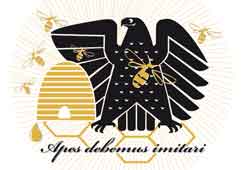- Softcover: 194 Seiten
- Verlag: sierke VERLAG – Sierke WWS GmbH
- Autor: Tim Koddenberg
- Auflage: 1. Aufl., erschienen am 19.12.2019
- ISBN-10: 3-96548-059-6
- ISBN-13: 978-3-96548-059-9
- Größe und/oder Gewicht: 21,0 x 14,8 cm
Three-Dimensional X-Ray Micro-Computed Tomography Imaging for Applications to the Structural Characterization of Wood
Autoren: Tim Koddenberg44,00 €

HONIGHÄUSCHEN (BONN) – Abstract Wood is a natural organic material with a heterogeneous cell tissue. Its porous and fibrous architecture is microscopically intricate and structured in three-dimensions. Because of this complexity and three-dimensionality, it is difficult to study spatial wood structure by two-dimensional imaging techniques (e.g. light microscopy and scanning electron microscopy) which are commonly used. In order to answer the call for a technique that overcomes the obstacles of conventional imaging in the study of the spatial structure of wood, this doctoral thesis has used a commercially available cone-beam X-ray micro-computed tomography system (XìCT). This thesis aimed at the micro-scale analysis of wood regarding the study of the qualitative and quantitative cell morphology, the distribution of inorganic particles in wood, and detection of structural changes of wood tissues. Therefore, XìCT was first applied to characterize anatomical features of the virgin softwood and hardwood species Pinus sylvestris, Fraxinus excelsior, and Syncarpia glomulifera in three-dimensions. Once the basic knowledge of the three-dimensional (3D) anatomy of wood and the potential applications of XìCT was available, XìCT has been applied on specially treated and decayed wood of Picea abies, Pinus sylvestris, and Quercus petraea for further structural characterization. Throughout the studies, this remarkable imaging technique has proven to be a valuable and complementary tool for determining the structural characterization of wood at the microscopic level. X-ray imaging simulates the 3D organization of wood by allowing the non-destructive examination of internal structures in otherwise opaque samples. In particular, the use of XìCT allows for arbitrary virtual sectioning through a digitalized sample and produces unprecedented 3D information of cellular structures. Although wood has a relatively low X-ray density due to its main organic elements, XìCT succeeded in visualizing cells in 3D, revealing a high variability in cell morphology, such as protrusions of tracheids in Pinus sylvestris as well as fibers and vessels in Fraxinus excelsior. Void imaging of cells facilitated the recognition and II comparison of cellular structures. Thereby, the 3D morphology and arrangement of cells of Fraxinus excelsior were captured and visualized at different resolutions. High-resolution (~1 ?m) scans allowed the appropriate identification and visualization of wood structures at the microscopic level; thus, high resolutions were mainly used for anatomical imaging. Low resolutions (>3 ?m) instead allowed a larger field of view and facilitated, for instance, the segmentation of vessel cells. Since X?CT succeeds in air-filled void imaging, it is possible for the first time to realize a direct volumetric measure of void volumes of different wood structures (e.g. volumes of cell lumina and bordered pits). Another strength of X?CT is the combination of qualitative and quantitative analysis, leading to an advanced level of structural characterization. Numerical findings of structures (e.g. cell-wall thicknesses and lumen diameters) could be appropriately evaluated and discussed when the findings are linked to tomographic visualizations. Apart from the organic wood material, the detection and distribution of inorganic deposits in wood here it was silicon dioxide particles in Australian wood of Syncarpia glomulifera and calcium oxalate particles in brown rot decomposed wood of Picea abies can be visualized and examined easily due to their higher X-ray density. Unlike the rapid analysis of inorganic deposits, the penetration of polyurethane adhesive, which has a similar X-ray density as wood, could only be studied by time-consuming and carefully applied image processing and analysis. Thereby, it was possible to track the adhesive penetration into the wood tissue via the wood rays. Despite these possibilities, researchers should nevertheless be aware that the cone-beam X?CT also has some shortcomings. In the analysis of small structures (e.g. pit membrane, fungal hyphae), these structures might not be detected correctly if the chosen resolution and image segmentation are insufficient. Since the X?CT device used in this thesis has limitations in resolving power and field of view, future improvements in X?CT technology could lead to a higher sampling of voxels and thus improve the 3D understanding of the spatial wood structure. Likewise, commercial X?CT does not provide any chemical information about inorganic constituents in wood. Their elemental compositions still need to be validated by energy-dispersive X-ray spectroscopy analyses. Apart from these technical aspects, researchers should also keep in mind that wood is a highly complex structured composite with a high natural variation in morphology and cells and tissue properties. Just as X?CT has proved to be a complementary method for characterizing wood, there is no reason to restrict data collection to only two-dimensional images. The shift toward an expeditious analysis of structural elements in wood and wood products in 3D could mark an important milestone in understanding the complex nature of wood tissues and the structure of wood products.
Über „Three-Dimensional X-Ray Micro-Computed Tomography Imaging for Applications to the Structural Characterization of Wood“
Das vorliegende Sachbuch zu Themen aus Umwelt und Natur „Three-Dimensional X-Ray Micro-Computed Tomography Imaging for Applications to the Structural Characterization of Wood“ wurde erarbeitet und verfasst von Tim Koddenberg. Dieses Sachbuch erschien am 19.12.2019 und wurde herausgegeben von sierke VERLAG – Sierke WWS GmbH.
Bücher wie „Three-Dimensional X-Ray Micro-Computed Tomography Imaging for Applications to the Structural Characterization of Wood“ sind im Onlineshop des Honighäuschens bestellbar. Online bestellte Fachbücher zur Imkerei und zu anderen Themen der Umwelt und des Artenschutzes sind zu den üblichen Öffnungszeiten auch direkt im Buchladen Bundesamt für magische Wesen in Bonn, der Stauhauptstadt von Nordrhein-Westfalen abholbar und werden auf Wunsch verschickt.
Das Thema Bienensterben, Rückgang von Insekten und allgemeines Artensterben ist in aller Munde und das Honighäuschen als frühere Bioland Imkerei hat sich von Anfang an daran beteiligt. Mehr als 35 Jahre Imkereierfahrung nahmen ihren Anfang 1982 mit den ersten eigenen Bienen.

Der zehnjährige Junge, der 1977 einem Hamburger Imker über die Schulter schaute; der Fünfzehnjährige, der mit der Imkerei in Zeiten begann, in denen es noch keine Varroamilbe gab; der achtzehnjährige Fahrschüler, der lernte, dass man die Windschutzsscheibe seines Autos nach einer längeren Fahrt von Insekten säubern muß; der zwanzigjährige Student, der für seine Bienen einen Platz in Bonn suchte; der dreißigjährige Berufsimker, der seinen Bienen quasi eine Gutenachtgeschichte erzählte und sich den Kopf zerbrach, wie man die Umwelt mit ihren Bienen, Wespen, Schmetterlingen und andere blütenbesuchenden Insekten vor den Machenschaften der Agrargiftindustrie und der Gleichgültigkeit agrarindustriehöriger Politiker schützt; der Imker, der nicht nur auf dem Weihnachtsmarkt Bonn die Öffentlichkeit suchte, um bei Führungen an den Bienen auf dem Dach der Bundeskunsthalle zu erleben, dass Kinder (und deren Helikoptermuttis!) Angst vor Schmetterlingen hatten, bis hin zum Begleiter von Forschungsprojekten zu den Riesenhonigbienen Nepals oder den Killerbienen Afrikas, stellt fest, dass etwas sehr im Argen liegt in unserem Umgang mit der Umwelt.
Es sollte jedem bewußt sein, dass die Haltung „Natur ja, aber bitte woanders!“ nicht in Ordnung ist.
Die wunderschöne Welt der Natur

In unserem Online-Buchshop finden Sie viele Bücher wie „Three-Dimensional X-Ray Micro-Computed Tomography Imaging for Applications to the Structural Characterization of Wood“, die Ihnen die fantastische Welt der Bienen, Wespen, Ameisen, Hornissen und Schmetterlinge sowie anderer Insekten näherbringen.
Aber nach wie vor stehe ich Ihnen auch gern zu einem Gespräch oder zu einer Beratung im Umgang mit Bienen, Wespen, Hornisse, Wildbienen und Hummeln zur Verfügung, wenn Sie Fragen haben. Besuchen Sie uns in Bonn im Bundesamt für magische Wesen.
Und natürlich gibt es auch weiterhin Honig, Bienenwachskerzen und Met bei uns und zwar das ganze Jahr – nicht nur zu Weihnachten.
| Gewicht | 325 g |
|---|---|
| Größe | 21 × 14,8 cm |





Bewertungen
Es gibt noch keine Rezensionen